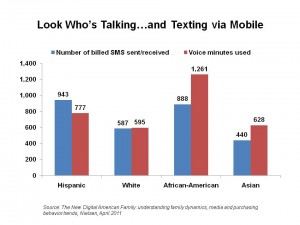 “Ward and June Cleaver have left the building,” observe analysts at Nielsen. “The white, two-parent, ‘Leave it to Beaver’ family unit of the 1950s has evolved into a multi-layered, multi-cultural construct dominated by older, childless households,” starts a report from The Nielsen Company, The New Digital American Family.
“Ward and June Cleaver have left the building,” observe analysts at Nielsen. “The white, two-parent, ‘Leave it to Beaver’ family unit of the 1950s has evolved into a multi-layered, multi-cultural construct dominated by older, childless households,” starts a report from The Nielsen Company, The New Digital American Family.
Whatever ethnic flavor this Digital Family may represent, there’s one equalizer across all of them: the smartphone, which is owned by households across cultures and income levels.
First, the socio-demographics paint a picture of increasingly multi-cultural households. Recent immigrants to the U.S. accounted for 90% of population growth from 2000-2010, over-indexing for Hispanic and Asian communities. Hispanics are the fastest-growing segment of the multi-cultural nation, now numbering 50 million people in the U.S. Marriage seems to be going out of fashion, with only 52% of adults being married in 2008 compared with 72% in 1960. In the next decade, households with young children will grow more slowly than in the past; the greatest growth will be among multi-cultural, lower/middle income families. Nielsen forecasts that most families with kids in the U.S. will be multi-cultural before the end of this decade.
Nielsen reveals fresh findings regarding family finance and media habits. Higher income families watch less TV but spend more TV-time with their kids; wealthier families also use digital video recorders 4x more than lower income households. Higher income families also use the Internet most, especially for conducting research, viewing news, and accessing travel information. While only 11% of Hispanics bank online, 30% do banking transactions on mobile phones.
Time-shifted viewing and 3-screen lifestyles (TV, Internet, mobile screens) are the new normal. Search 1.0 has morphed to social networks 2.0 for travel, health and other topics, Nielsen notes.
Health Populi’s Hot Points: “The Internet is more than a way to study the world; it is a mechanism for building community,” Nielsen concludes. This phenomenon can profoundly impact health for an individual and for populations. Whether influencing Mobile Moms, asthmatic kids, or seniors managing COPD, the smartphone is that great leveler according to Nielsen’s survey data. Web preferences differ across income and ethnic lines. Thus, the mobile platform may be universal, but messaging and design must account for health-user preferences and cultural norms.
Smartphone penetration is 45% among Hispanics in the U.S., matching that for Asians. The chart illustrates that Hispanics are more likely to text than whites are, and Asian people, much less overall. But Nielsen’s data show that Asian-Americans are much more likely to stream video online than the national average.
Health behaviors can be inspired and sustained by using mobile platforms where people live, work and play. But organizations seeking to influence such behavior need to keep usability, design and consumer preferences in mind in the emerging era of the New Digital, Multi-Cultural Family.




 I am so grateful to Tom Lawry for asking me to pen the foreword for his book, Health Care Nation,
I am so grateful to Tom Lawry for asking me to pen the foreword for his book, Health Care Nation,  I love sharing perspectives on what's shaping the future of health care, and appreciate the opportunity to be collaborating once again with Duke Corporate Education and a global client on 6th May. We'll be addressing some key pillars to consider in scenario planning such as growing consumerism in health care, technology (from AI to telehealth), climate change, and trust -- the key enabler for health engagement or dis-engagement and mis-information. I'm grateful to be affiliated with the corporate education provider
I love sharing perspectives on what's shaping the future of health care, and appreciate the opportunity to be collaborating once again with Duke Corporate Education and a global client on 6th May. We'll be addressing some key pillars to consider in scenario planning such as growing consumerism in health care, technology (from AI to telehealth), climate change, and trust -- the key enabler for health engagement or dis-engagement and mis-information. I'm grateful to be affiliated with the corporate education provider  Thank you FeedSpot for
Thank you FeedSpot for